 On July 22, 2016, the Holy See issued the Apostolic Constitution Vultum Dei Quaerere (“Seeking the Face of God”) on women’s contemplative life.
On July 22, 2016, the Holy See issued the Apostolic Constitution Vultum Dei Quaerere (“Seeking the Face of God”) on women’s contemplative life.
In the document, the Holy Father called for reflection and discernment on twelve aspects of consecrated life in general and the monastic tradition in particular:
- Formation – the “process aimed at configuration to the Lord Jesus and the assimilation of His mind and heart in the complete gift of self to the Father.” One startling thing was noted: “for initial formation and that following temporary profession, to the extent possible, ‘ample time must be reserved,’ no less than nine years and not more than twelve.”
- Prayer – must not be “self-absorption; it must enlarge your heart to embrace all humanity.” “By your prayers, you can heal the wounds of many.”
- The centrality of the world of God – “Lectio divina,” the prayerful reading of God’s word, bridging the gap between spirituality and everyday life. Lectio divina is “not concluded until it arrives at action (actio) which moves the believer to make his or her life a gift for others in charity.”
- The sacraments of the Eucharist and Reconciliation – “The Eucharist is the heart of of the life of every baptized person and of the consecrated life itself.” Adoration is also praiseworthy. Reconciliation grants one the “grace and to become prophets and ministers of His mercy.”
- Fraternal Life in Community – Seeking to become “one heart and one soul” as modeled by the early Christian communities, “an eloquent witness to the Trinity,” a witness to a world marked by inequality and divisions.
- The autonomy of Monasteries – Autonomy favors stability of life ad internal unity but it should not mean independence or isolation, especially from other monasteries of the same family.
- Federations – Are important structures of communion between those sharing the same charism, ensuring assistance in initial and continuous formation and practical needs. Federations are encouraged.
- The cloister – “A sign of the exclusive union of the Church as Bride with her Lord.” It takes four forms: the one common to all, papal, constitutional and monastic.
- Work – Through labor you share in the work of God, and with those who live by the fruit of their toil and the poor. Ora et labora.
- Silence – Entails self-emptying to grow in receptivity. Mary Most Holy is the example.
- The communications media – Prudent discernment is necessary.
- Asceticism – Liberation from worldliness; stability is also a sign of fidelity, a witness to people who never sink down roots.
A nice reflection by Ann Carey with comments from Fr. Thomas Nelson, O.Praem., can be found here.